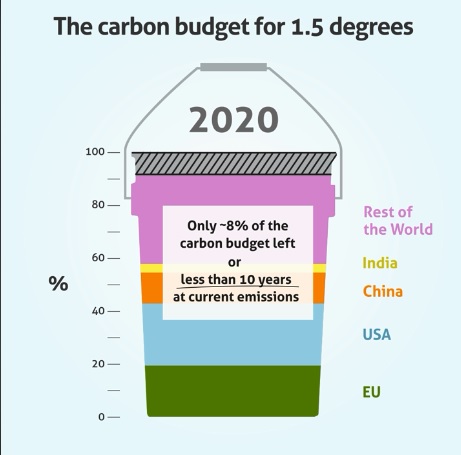What is the issue?
The net zero campaign has been gaining momentum as a number of countries and non-state actors are pushing for the world’s carbon dioxide emissions to reach net zero.
What targets have been set by the countries towards net zero emissions?
IPCC AR6 emphasised that to keep temperature rise within 1.5°C, global emissions should be reduced by 45% from 2010 levels by 2030, on the way to net zero 2050.
- Developed countries – Countries such as the U.S., UK and Australia have committed to to achieve the goal of net zero GHG emissions by 2050.
- Developing countries – Countries such as China have pledged to achieve net zero emissions by 2060.
- India hasn’t set any net zero target so far.
- Non state actors - Race To Zero is a UN-led campaign is asking cities, businesses, universities, and more to hit net zero emissions.
Can net zero contain the global temperature rise within 1.5°C?
- The stringent limits on future cumulative emissions post 2020, amounts to less than a fifth of the total global carbon budget.
- The top three emitters of the world — China, the U.S. and the European Union — even after taking account of their net zero commitments will emit more than 500 billion tonnes of CO2 before net zero.
- These committed emissions will undermine the basic purpose of net zero.
- The failure of the developed world to meet its pre-2020 obligations provides little confidence.
- Neither the Paris Agreement nor climate science requires that net zero be reached individually by countries by 2050.
- Less than a fifth of the world has been responsible for three-fifths of all past cumulative emissions.
- But the current net zero campaign pushes the developing countries for emission reduction despite their already low emissions.

What India must do?
India’s per capita emissions are less than half the world average and less than one-eighth of the U.S.’s.
- India’s contribution to global emissions, in both stock and flow, is so disproportionately low.
- India’s commitment to net zero would endanger the future of its own population allowing the developed countries to continue the exploitation.
- India should enable the responsible use of coal, oil and gas to come out of lower middle-income economy status and for its socio-economic development.
- India’s small industries sector which provides employment and livelihood to the majority of the population outside agriculture, needs expansion and modernisation.
- The agriculture sector, the second largest source of GHG emissions for India after energy, needs to double its productivity and farmers’ incomes and build resilience.
- Infrastructure for climate resilience in general is critical to future adaptation to climate change.
- India cannot sign on to net zero, without the big emitters taking their fair share of the global carbon budget.
Carbon Budget is the estimated amount of carbon dioxide the world can emit still having a likely chance of limiting global temperature rise to 2°C above pre-industrial levels.
The budget is estimated to be around 1 trillion tonnes of carbon. The Global Carbon Budget is produced under the umbrella of Global Carbon Project (GCP).
